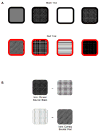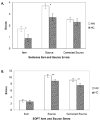HIV-associated episodic memory impairment: evidence of a possible differential deficit in source memory for complex visual stimuli
- PMID: 19622690
- PMCID: PMC2774938
- DOI: 10.1176/jnp.2009.21.2.189
HIV-associated episodic memory impairment: evidence of a possible differential deficit in source memory for complex visual stimuli
Abstract
HIV infection is often associated with frontal systems pathology and related deficits in the strategic encoding and retrieval aspects of episodic memory. However, no prior HIV studies have explicitly examined source memory, which refers to recall of information regarding the context in which a declarative memory was formed. Source memory is heavily reliant on frontal systems and strategic cognitive processes and is singly dissociable from the content of the memory (i.e., item memory), which is more dependent on medial temporal systems and automatic processes. The present study examined item and source memory in 60 individuals with HIV infection and 35 demographically similar seronegative participants. The primary finding of interest was a significant HIV effect on source (but not item) memory for complex visual stimuli. Follow-up correlational analyses showed a significant association between visual source memory errors and impairment on measures of executive functions, working memory, and higher-level list learning encoding strategies. These findings extend the hypothesized profile of strategic encoding and retrieval deficits in HIV to the construct of source memory, which may be differentially affected relative to item memory for complex visual stimuli.
Figures


Similar articles
-
Visual memory in methamphetamine-dependent individuals: deficient strategic control of encoding and retrieval.Aust N Z J Psychiatry. 2012 Feb;46(2):141-52. doi: 10.1177/0004867411433212. Aust N Z J Psychiatry. 2012. PMID: 22311530 Free PMC article.
-
Verbal episodic memory profiles in HIV-Associated Neurocognitive Disorders (HAND): A comparison with Huntington's disease and mesial temporal lobe epilepsy.Appl Neuropsychol Adult. 2019 Jan-Feb;26(1):17-27. doi: 10.1080/23279095.2017.1353993. Epub 2017 Aug 29. Appl Neuropsychol Adult. 2019. PMID: 28850256 Free PMC article.
-
Visuospatial temporal order memory deficits in older adults with HIV infection.Cogn Behav Neurol. 2013 Dec;26(4):171-80. doi: 10.1097/WNN.0000000000000013. Cogn Behav Neurol. 2013. PMID: 24378603 Free PMC article.
-
Antiretroviral Non-Adherence is Associated With a Retrieval Profile of Deficits in Verbal Episodic Memory.Clin Neuropsychol. 2015;29(2):197-213. doi: 10.1080/13854046.2015.1018950. Epub 2015 Mar 17. Clin Neuropsychol. 2015. PMID: 25781903 Free PMC article.
-
[Functioning of memory in subjects with autism].Encephale. 2008 Dec;34(6):550-6. doi: 10.1016/j.encep.2007.10.010. Epub 2008 Mar 4. Encephale. 2008. PMID: 19081450 Review. French.
Cited by
-
Nicotine attenuates the effect of HIV-1 proteins on the neural circuits of working and contextual memories.Mol Brain. 2015 Jul 24;8:43. doi: 10.1186/s13041-015-0134-x. Mol Brain. 2015. PMID: 26205781 Free PMC article.
-
Central nervous system penetration effectiveness of antiretroviral drugs and neuropsychological impairment in the Ontario HIV Treatment Network Cohort Study.J Neurovirol. 2016 Jun;22(3):349-57. doi: 10.1007/s13365-015-0404-5. Epub 2015 Nov 16. J Neurovirol. 2016. PMID: 26572786 Free PMC article.
-
Intraindividual variability in HIV infection: evidence for greater neurocognitive dispersion in older HIV seropositive adults.Neuropsychology. 2011 Sep;25(5):645-54. doi: 10.1037/a0023792. Neuropsychology. 2011. PMID: 21574712 Free PMC article.
-
Microglial HIV-1 Expression: Role in HIV-1 Associated Neurocognitive Disorders.Viruses. 2021 May 17;13(5):924. doi: 10.3390/v13050924. Viruses. 2021. PMID: 34067600 Free PMC article.
-
Defects in immune response to Toxoplasma gondii are associated with enhanced HIV-1-related neurocognitive impairment in co-infected patients.PLoS One. 2023 May 24;18(5):e0285976. doi: 10.1371/journal.pone.0285976. eCollection 2023. PLoS One. 2023. PMID: 37224128 Free PMC article.
References
-
- Davis LE, Hjelle BL, Miller VE, et al. Early viral brain invasion in iatrogenic human immunodeficiency virus infection. Neurology. 1992;42:1736–1739. - PubMed
-
- Gonzalez-Scarano F, Martin-Garcia J. The neuropathogenesis of AIDS. Nat Rev Immunol. 2005;5:69–81. - PubMed
-
- Budka H. The neuropathology of HIV-associated brain disease. In: Gendelman HE, Grant I, Everall I, et al., editors. The neurology of AIDS. 2nd. New York: Oxford University Press; 2005. pp. 375–391.
-
- Ellis R, Langford D, Masliah E. HIV and antiretroviral therapy in the brain: neuronal injury and repair. Nat Rev Neurosci. 2007;8:33–44. - PubMed
Publication types
MeSH terms
Grants and funding
LinkOut - more resources
Full Text Sources
Medical

